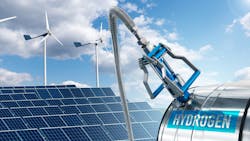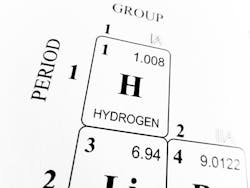READ MORE: Building the Hydrogen Highway
Researchers and engineers around the globe are developing and refining ways to generate, store, transport and distribute clean, fossil-free energy. One of the most promising approaches, dubbed the Hydrogen Economy, relies on hydrogen to handle these tasks.
Hydrogen’s Advantage
Hydrogen is readily available and there is an inexhaustible supply of it bound up in Earth’s oceans, lakes and waterways. It just takes electrolysis to separate and release the hydrogen (and oxygen) from the water. Of course, it also takes electricity which, in the Hydrogen Economy, would be generated by renewables such as solar panels and wind turbines. Using fossil-free renewables rather than coal or natural gas to supply the electricity keeps the resulting hydrogen green.
Until recently, however, the cost of hydrogen was too expensive for it to compete with gasoline and natural gas. Fortunately, technological advances have taken the cost of hydrogen from about $25/kg down to $4/kg. This alone makes hydrogen more cost-effective than gasoline. A $4 kilo of hydrogen gives an average fuel-cell equipped car an 80-mile range. It would take 2.4 gallons of gas, or $7.2 at $3/gallon, to do the same for a gas-powered car.
READ MORE: Hydrogen-Powered Ship on the Drawing Board
The cost of hydrogen should also go down if it were electrolyzed using wind or solar power where it is the least expensive. For example, a solar panel in the Sahara generates at least three times the electricity as the same panel in Northern Europe. In fact, covering just 1% of the Sahara with solar panels would create enough energy to power the whole planet. There are geographic locations where wind and sunlight are abundant, letting clean electricity be made for $0.01 per kilowatt-hour (kWh). By comparison, the lowest cost to produce electricity by burning natural gas is roughly $0.05 per kWh.
So one of the pillars of the Hydrogen Economy is to place wind and solar farms where they are most efficient at generating electricity, then using that electricity to electrolyze water and extract hydrogen. Next, the hydrogen would be transported and distributed to distant plants and facilities, including hydrogen refueling stations for cars and other vehicles.
To maximize the amount hydrogen transport vehicle or pipeline would have to move, the low-cost electricity from the solar panels or wind turbines could also be used to cryogenically cool the hydrogen until it is liquid. This would make the hydrogen more energy dense and reduce the volume needed to be transported.
“Water will be the coal of the future.”
—Jules Verne
Once at its destination, hydrogen can be burned to generate enough electricity to power large-scale users such as steel plants and aircraft or put in large or small fuel cells, an invention from 1838, to create electricity. In either case, the only “waste” product is water vapor.
Batteries or Hydrogen Fuel Cells?
One of the major uses of hydrogen foreseen by those pushing the Hydrogen Economy is to power fuel cells for electric cars and trucks. Currently, most automakers seem to be opting for batteries to meet the need for electric vehicles. However, batteries have some significant issues. For example, lithium-ion batteries rely on nickel and cobalt which must be mined and refined—two environmentally risky tasks. There are also no good answers on how all those batteries will be recycled or disposed of. These problems may be sidestepped with cleaner solid-state batteries being developed, but that is a hope, not a certainty.
READ MORE: Natural Membrane Extracts Hydrogen from Water
By contrast, fuel cells have long lives and replacing their filters let them be reused, a sustainable proposition. Fuel cell also outdistance batteries in terms of range, and range is a major consumer concern regarding electric vehicles. A fuel cell car can also be quickly refueled in 4 min. and given a 350-mile range. A 20- to 30-minute “quick” recharge from a rapid charger only gives the car about 200 miles of travel.
The price of hydrogen will likely continue falling, which will make fuel-cell cars even more attractive. But experts forecast that ultimately cars will probably have fuel cells as well as cleaner solid-state batteries, combining the best of both technologies,
Hydrogen’s Dark Side
Some people might needlessly worry that large-scale electrolysis to make hydrogen would eventually lead to a shortage of water. They are unaware that currently it takes several times more water to mine, frack, and refine coal, oil, and gas than would be needed to electrolyze enough hydrogen to power the world. In addition, each pound of hydrogen burned or turned into electricity creates four gallons of water as a byproduct.
Another downside of hydrogen is the perception that it is inherently unsafe and a dangerous fire and explosion hazard. That perception stems largely from the Hindenburg disaster in which the airship burst into flame as it was landing in New Jersey back in 1937. The fiery crash was seen worldwide as it was filmed for newsreel distribution. And although it was a tragedy, “only” 13 of 36 passengers and 22 of 61 crewmen were killed. But until then, dirigibles using hydrogen for lift had flown safely for 27 years and the Hindenburg had safely flown millions of miles safely before its sad end.
Hydrogen can be highly flammable, but modern safety devices, protocols and technology should make hydrogen-fuel-cell powered vehicles—even dirigibles—as safe or safer than other forms of transportation.
“Since the Hindenburg crash, there have been enormous advances in materials, sensors, and controls used in airships and real-time in-flight weather telemetry has significantly improved margins of safety for dirigibles,” says Rinaldo Brutoco, CEO and founder of H2 Clipper, a company designing dirigibles to transport up to 200 tons of liquid hydrogen per flight.
READ MORE: Zero-Emission Heater Lets Reformer Cleanly Turn Methane into Hydrogen
Many engineers and scientists argue that hydrogen is a far safer fuel than oil or gas. They point out that it is light and if there is an accident or leak, the hydrogen floats up into the sky and disperses at concentrations below 4%, the concentration at which hydrogen becomes explosive. For comparison, leaked gas and stays on the ground evaporates into the air where it is flammable at concentrations of just 1.4%. And if there is a leak, hydrogen, unlike gas or oil, is non-toxic, so it will not contaminate the air, ground, or water. Hydrogen flames also emit low radiant energy compared to gas or oil fires, so they are less likely to spread.
Electric cars and trucks powered by hydrogen fuel cells have been extensively tested for fire hazards. For example, test show that a rifle fired at a tank filled with gas, diesel fuel or natural gas, will make the tank explode. The same rifle shot into a hydrogen tank will put a hole in the tank and hydrogen will escape, but there won’t be an explosion. Other tests reveal that if gas leaking from a car is ignited, the tank will explode and burn the entire vehicle. But igniting a leak in a hydrogen tank just ignites a faint blue flame as escaping hydrogen leaves the tank until all the hydrogen is exhausted; it does not lead to an explosion nor does it raise the temperature inside the car by more than a couple of degrees.
In real-world testing, Honda, Toyota and Hyundai sell hydrogen fuel cell cars in California. And although ordinary drivers have refueled their hydrogen-powered cars over 60,000 times, no explosions have been reported.
Hydrogen does pose some risks, but what doesn’t? The Lancet medical journal reported in 2007 that coal production annually kills 24 people per terawatt hour (TWh) of energy produced. For oil, the death toll per TWh is 18 and for natural gas it is 3. (The U.S consumes roughly 4,000 TWh annually). The larger threat from burning fossil fuels, however, is the air pollution it creates. In 2021, the World Health Organization said that air pollution is “the single largest environmental threat to human health and well-being.” The organization estimates than 4 million people a year die prematurely due to air pollution. So a clean, green Hydrogen Economy should save lives.
The Major Move to Hydrogen
Around the world companies and government are recognizing that hydrogen is an abundant source of low-cost, clean energy. Not wanting to be left behind in the race to incorporate hydrogen into their energy strategies, over 30 countries having released plans for hydrogen and more than 200 projects backed by more than $70 billion in public funding have been announced by industry, according to McKinsey & Co.
“Hydrogen is the missing link to a climate-safe energy future.”
—Francesco La Camera, Director-General of the International Renewable Energy Agency
The U.S. announced “Energy Earthshot” a program which intends to lower the cost of green hydrogen to $1 per kilogram within a decade. European governments and energy companies are working with Morocco and Algeria to build solar and windfarms to produce green hydrogen. Their next step is to transport the hydrogen to Europe with tankers and pipelines to Europe.
Saudi Arabia and the United Arab Emirates know the future of oil is limited, so they want to get on the hydrogen bandwagon as well and are investing billions in giant solar plants that will make hydrogen and ship to other countries via tankers. Saudi Arabia, for example, is investing $5 billion in a green hydrogen plant at Neom, a planned city. Australia, Korea, UAE, Chile, Morocco and Brazil, as well as multinational corporations such as Shell, BP and Toyota, are also investing in green hydrogen production.

